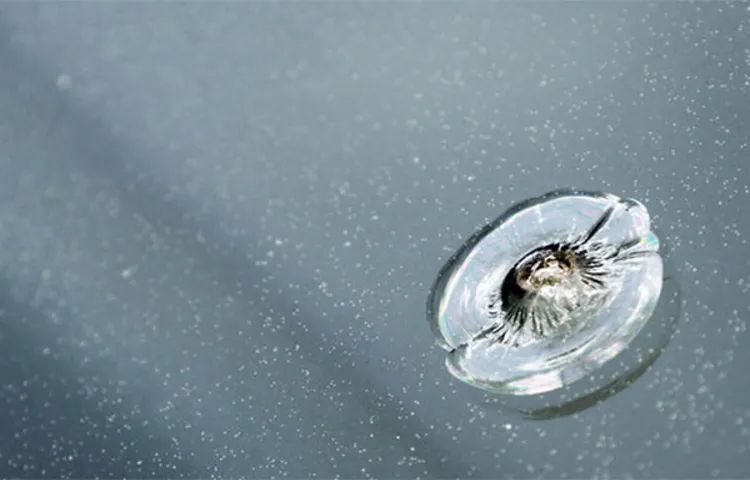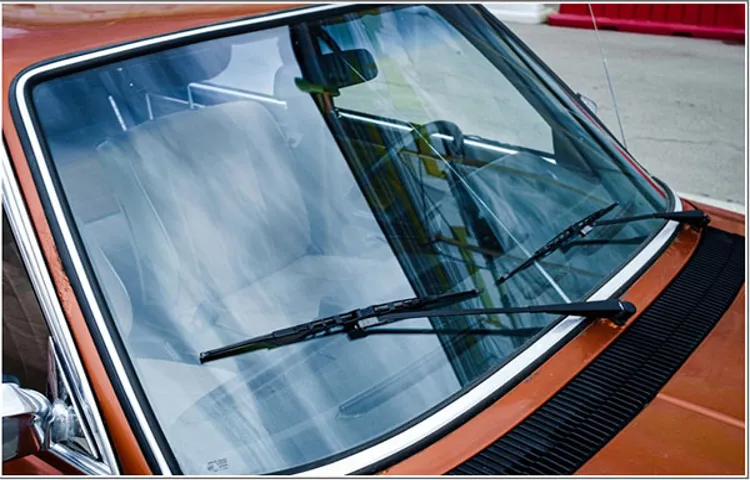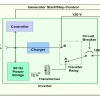Have you ever found yourself staring at a small chip or crack on your windshield, wondering if it’s worth repairing? While it may be tempting to ignore these surface damages, they can quickly worsen and become a safety hazard. But fear not, because repairing windshield surface damage is easier than you might think. Imagine your windshield as a protective shield, shielding you from the elements and potential dangers on the road.
Just like any shield, it needs to be in top-notch condition to provide maximum protection. A chip or crack in your windshield weakens its structural integrity, making it more susceptible to shattering upon impact. Think of it as a tiny crack in a dam.
If left unattended, it has the potential to grow and compromise the entire structure. The same principle applies to your windshield. By addressing surface damages early on, you can prevent them from spreading and potentially save yourself from costly repairs or even having to replace the entire windshield.
Repairing windshield surface damage has never been easier, thanks to advancements in technology and the availability of DIY repair kits. These kits typically come with all the necessary tools and materials, including resin, to fill in the chip or crack. The repair process involves cleaning the damaged area, applying the resin, and using a curing light to harden it.
With a little patience and attention to detail, you can restore your windshield to its former pristine condition. Not only does repairing windshield surface damage enhance the aesthetics of your vehicle, but it also improves your visibility on the road. A chipped or cracked windshield can distort your view, making it difficult to spot potential hazards or obstacles.
By repairing the damage, you ensure clear visibility, which is crucial for safe driving. It’s like putting on a pair of clean glasses – suddenly, everything becomes sharper and more focused. So, the next time you notice a chip or crack on your windshield, don’t wait for it to become a bigger problem.
Table of Contents
Introduction
If you have a chip or crack on your windshield, it’s important to address it as soon as possible. Not only can these damages obstruct your vision while driving, but they can also compromise the structural integrity of the glass. Fortunately, there are ways to repair windshield surface damage without having to replace the entire windshield.
One option is to use a windshield repair kit, which typically includes a resin that can fill in the damaged area. This resin is designed to harden and bond with the glass, creating a strong and durable repair. Another option is to consult with a professional windshield repair technician who can assess the damage and provide the best solution.
It’s important to remember that while these repairs can often be successful, they may not completely eliminate the appearance of the damage. However, they can prevent further spreading and ensure that your windshield remains safe and functional. So, if you want to save time and money and avoid the hassle of replacing your windshield, consider repairing the surface damage instead.
Understanding the Problem
“Understanding the Problem” Introduction: Have you ever faced a problem that seemed impossible to solve? Maybe you couldn’t figure out how to fix a broken sink or find a solution to a complex math equation. We all encounter problems in our day-to-day lives, and sometimes they can be quite challenging. But why is it that some problems seem more difficult to solve than others? In this blog post, we will explore the concept of problem understanding and how it impacts our ability to find solutions.
So, grab a cup of coffee and get ready to dive into the fascinating world of problem-solving!

Causes of Windshield Surface Damage
windshield surface damage Windshield surface damage is a common problem that many car owners face. It can be caused by a variety of factors, ranging from environmental elements to accidents. One of the most common causes of windshield surface damage is road debris.
As we drive, our windshields are bombarded by small rocks, gravel, and other particles that are kicked up by passing cars. These particles can cause scratches and chips on the surface of the windshield, compromising its integrity and reducing visibility. Another potential cause of windshield surface damage is extreme changes in temperature.
When the temperature fluctuates rapidly, the glass can expand and contract, leading to cracks and chips. Additionally, accidents can also result in windshield surface damage. Even a minor fender bender can cause the glass to crack or shatter.
It is important to address windshield surface damage as soon as possible, as it can compromise the safety of the vehicle and its occupants.
Assessing the Damage
If you notice any surface damage on your windshield, it’s important to address it as soon as possible to avoid further complications. Although minor scratches and chips may seem harmless at first, they can quickly worsen and lead to a more serious issue. To repair windshield surface damage, there are a few options to consider depending on the severity of the damage.
For small chips or scratches, you can use a repair kit that includes a resin to fill in the damaged area. This can help prevent further spreading and restore the appearance of your windshield. However, if the damage is more significant or if the crack extends beyond the surface of the glass, it may be necessary to replace the entire windshield.
In these cases, it’s best to consult a professional for an accurate assessment and to ensure the proper repair or replacement is done. Remember, taking care of your windshield is not only important for your safety but also for the overall longevity of your vehicle. So, don’t wait too long to address any surface damage!
Inspecting the Windshield
When it comes to assessing the damage on your windshield, it’s important to take a close look at the severity of the impact. Is it a tiny chip or a large crack? This will determine whether or not it can be repaired or if a full replacement is needed. One way to assess the damage is by measuring the size of the impact.
Small chips that are less than the size of a quarter can often be repaired. However, if the damage is larger than this, it may require a full windshield replacement. Additionally, it’s important to inspect the location of the damage.
If it’s directly in the driver’s line of sight, it can be a major hazard and should be addressed as soon as possible. Another factor to consider is the depth of the damage. If it’s only superficial, it may be possible to repair it.
However, if the damage extends all the way through the glass, a replacement may be necessary. By carefully assessing the damage on your windshield, you can make an informed decision on how to proceed and ensure your safety on the road.
Determining the Extent of the Damage
When a disaster strikes, one of the first things that needs to be done is to assess the extent of the damage. This is an important step in the recovery process as it helps determine the scope of the work that needs to be done and the resources that will be required. Assessing the damage involves surveying the affected area and documenting any visible signs of damage.
This can include taking photographs, making notes, and even creating diagrams to help visualize the extent of the damage. In addition to visual assessment, it may also be necessary to conduct more detailed inspections to determine the structural integrity of buildings and infrastructure. This could involve testing the stability of walls, floors, and ceilings, as well as checking for any hidden damage that may not be immediately apparent.
Overall, assessing the damage is a crucial step in the recovery process as it provides a clear picture of what needs to be done and helps to prioritize the necessary repairs and restorations.
Identifying the Type of Damage
Assessing the Damage: Identifying the Type of Damage When it comes to assessing damage, the first step is to identify the type of damage that has occurred. This will help determine the best course of action for repairs and restoration. There are several common types of damage that can occur, including water damage, fire damage, mold damage, and structural damage.
Water damage can be caused by leaks, flooding, or plumbing issues. It can lead to the growth of mold and mildew if not addressed promptly. Fire damage can be caused by flames, smoke, and heat.
It can result in structural damage as well as damage to personal belongings. Mold damage can occur when there is excess moisture and can lead to respiratory issues and other health problems. Structural damage can occur due to structural defects, natural disasters, or wear and tear over time.
It can compromise the safety and stability of a building. Identifying the type of damage is crucial because each type requires a specific approach for repairs and restoration. For example, water damage may require drying out the affected area, repairing leaks, and removing mold.
Fire damage may involve cleaning smoke residue, repairing structural damage, and replacing damaged items. Mold damage may require removing mold growth, fixing the source of moisture, and improving ventilation. Structural damage may necessitate reinforcing weakened areas, repairing or replacing damaged materials, and ensuring the overall stability of the structure.
By accurately assessing the type of damage, professionals can design a tailored plan to address the specific issues and restore the property to its pre-damaged condition. This ensures that the right techniques, equipment, and materials are used for effective and efficient restoration.
Repairing the Damage
If your windshield has surface damage, you may be wondering how to go about repairing it. Luckily, there are a few options available to you. One option is to use a windshield repair kit.
These kits typically contain a resin that can fill in small cracks or chips in the glass. All you need to do is apply the resin to the damaged area, let it dry, and then polish the surface. Another option is to take your car to a professional windshield repair service.
These professionals have specialized tools and techniques to fix more serious damage, such as large cracks or shattered glass. They can often restore your windshield to its original condition. Ultimately, the best course of action will depend on the severity of the damage and your budget.
Remember, though, that it’s important to address windshield damage as soon as possible to prevent it from spreading and causing further issues. So don’t delay in getting your windshield repaired!
DIY Methods for Minor Surface Damage
If you’re dealing with minor surface damage on furniture or other household items, don’t panic! There are several DIY methods you can try to repair the damage and make your belongings look as good as new. One popular method is using a wood filler or putty to fill in any cracks or gouges. Simply apply the filler to the damaged area, smooth it out with a putty knife, and let it dry.
Once dry, you can sand it down to make it flush with the surface and then paint or stain it to match the surrounding area. Another option is using a touch-up marker or crayon to color in any scratches or scuffs. Simply choose a marker or crayon that matches the color of your furniture, and carefully fill in the damaged area.
You can then use a cloth to blend it in and make it less noticeable. These DIY methods are great for minor surface damage and can save you the hassle of replacing or repairing the entire piece.
Professional Repair Options
professional repair options, repairing the damage When it comes to fixing something that’s been damaged, sometimes it’s best to leave it to the professionals. Whether it’s a broken phone screen, a malfunctioning computer, or a car with engine troubles, professional repair options offer expertise and peace of mind. These experts have the knowledge and skills to assess the damage, diagnose the problem, and come up with a solution.
They have access to specialized tools and equipment, as well as the latest techniques and technologies. And perhaps most importantly, they have experience dealing with all kinds of damage, so they know what works and what doesn’t. So instead of trying to fix it yourself and potentially making the problem worse, consider entrusting your damaged items to professional repair services.
They can save you time, money, and unnecessary stress, and return your items to their former glory in no time.
Replacing the Windshield
windshield replacement, repairing the damage
Preventing Future Damage
When it comes to preserving the integrity of your windshield, preventing damage is key. One effective way to prevent future damage is by regularly examining the surface of your windshield for any signs of wear and tear. This can include looking for small chips or cracks that may have developed over time.
If you notice any damage, it’s important to address it as soon as possible to prevent further deterioration. Another preventive measure is to avoid parking your vehicle under trees or in areas where falling debris is common. Additionally, maintaining a safe distance from other vehicles on the road can prevent rocks and other objects from being flung up towards your windshield.
By being proactive and taking these preventive measures, you can avoid costly repairs and ensure that your windshield remains in good condition for years to come. So next time you hop in your car, take a moment to inspect your windshield and protect it from any potential damage.
Protective Measures
One of the most important steps in protecting yourself from future damage is to take proactive measures to prevent it from happening again. This means being aware of potential risks and taking action to minimize them. For example, if you live in an area prone to flooding, you might consider investing in flood insurance and taking steps to waterproof your home.
Similarly, if you live in an area with a high crime rate, you might invest in a home security system and take precautions such as keeping your doors and windows locked at all times. It’s also important to stay informed about potential risks and to be prepared for emergencies. This might involve creating an emergency plan and having necessary supplies on hand.
By taking these steps, you can significantly reduce the risk of future damage and protect yourself and your property. So, the next time you find yourself dealing with the aftermath of a disaster, remember that there are steps you can take to prevent it from happening again.
Safe Driving Practices
maintenance of a vehicle. To prevent future damage and ensure a safe driving experience, it is crucial to follow some essential practices. One of the most important things to do is to regularly check and maintain the fluid levels in your vehicle.
This includes engine oil, brake fluid, coolant, and transmission fluid. Without proper fluid levels, your car’s engine may overheat or seize up, resulting in expensive repairs. By checking and topping up these fluids regularly, you can prevent potential damage and keep your vehicle running smoothly.
Another important practice is to regularly inspect and replace worn-out parts. This includes checking your tires for tread wear and replacing them when necessary. Worn-out tires can lead to poor handling and reduced traction, especially in wet or icy conditions.
Additionally, regularly inspecting and replacing worn-out brakes can prevent accidents and ensure your car stops when you need it to. Additionally, it is vital to schedule regular maintenance appointments with a qualified mechanic. These appointments allow the mechanic to thoroughly inspect your vehicle and address any potential issues before they become major problems.
This preventative maintenance can save you time, money, and frustration in the long run. Taking care of your vehicle’s body and paintwork is also essential in preventing future damage. Regularly washing and waxing your car helps protect the paint from oxidation and damage caused by environmental elements.
It is also important to promptly address any dents or scratches to prevent rust and further damage to the body of your vehicle. Lastly, practicing safe driving habits is crucial in preventing future damage to yourself and your vehicle. This includes obeying speed limits, avoiding aggressive driving behaviors, and maintaining a safe following distance.
Regular Maintenance
Regular maintenance is crucial for preventing future damage to your property. By taking proactive steps to maintain your property, you can save yourself from costly repairs down the line. One way to prevent future damage is by regularly inspecting your property for signs of wear and tear.
Look for any cracks, leaks, or other signs of damage and address them promptly. Additionally, make sure to clean and maintain your property’s systems and equipment regularly. This includes servicing your HVAC system, cleaning out your gutters, and inspecting and repairing any damaged wiring or pipes.
By making regular maintenance a priority, you can prolong the lifespan of your property and avoid the headaches and expenses that come with major repairs. So take the time to schedule regular maintenance tasks and protect your investment for years to come.
Conclusion
In conclusion, repairing windshield surface damage is not just about fixing the cracks and chips. It’s about restoring the beauty and resilience that only a perfectly smooth glass can provide. It’s about giving your windshield a second chance at life, a chance to laugh in the face of those pesky pebbles and rebellious road debris.
So, next time you find yourself in a sticky situation, don’t despair, grab your repair kit and let your windshield shine brighter than a supernova on a clear night. After all, a repaired windshield is like a good joke – it’s a clever and witty way to say, “I’m not letting anything break my stride.”
FAQs
What are the common causes of windshield surface damage?
The common causes of windshield surface damage include rocks or debris that hit the windshield while driving, extreme temperature changes, and improper maintenance or cleaning techniques.
Can windshield surface damage be repaired?
Yes, minor surface damage such as small chips or cracks can often be repaired using various windshield repair kits or professional services.
How does windshield repair work?
Windshield repair typically involves injecting a resin into the damaged area, which helps to fill in the cracks or chips. The resin is then hardened and polished, restoring the structural integrity and visibility of the windshield.
Is it possible to prevent windshield surface damage?
While it’s not always possible to prevent windshield surface damage completely, there are steps you can take to minimize the risk. These include maintaining a safe following distance, avoiding driving behind large trucks or construction vehicles, and using protective coverings during extreme weather conditions.
What should I do if I notice windshield surface damage?
If you notice windshield surface damage, it’s important to address it as soon as possible. Small chips or cracks can quickly spread and worsen with time, which may require a complete windshield replacement instead of a simple repair.
Can I drive with windshield surface damage?
It is generally not recommended to drive with windshield surface damage, as it can compromise the structural integrity of the windshield and impede your visibility. It’s best to have any damage assessed and repaired before resuming normal driving.
How much does it cost to repair windshield surface damage?
The cost of repairing windshield surface damage can vary depending on the severity and location of the damage, as well as your location and the service provider you choose. On average, repairs can range from $50 to $200, but it’s best to get a quote from a professional for an accurate estimate.



